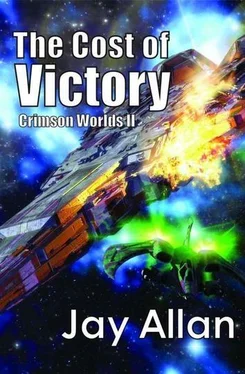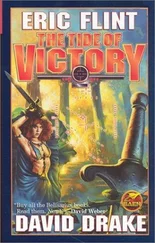Forces of ships that approach each other at high velocities will generally exchange fire briefly before passing each other and quickly moving beyond effective range while they decelerate.
Fleets intending to fight protracted engagements are likely to do so at relatively slow speed, which allows them to remain in contact with each other for a longer period and react more effectively to each others' maneuvers. In theory, two forces could move at high speeds on parallel vectors and engage in a running fight, but this is very difficult to achieve, and so it is rare.
Ships at low velocities are able to perform evasive maneuvers more easily because they can change their direction in unpredictable ways. This can be counter-intuitive to the Earthbound mind.
Space battles are often protracted affairs, with extended maneuver and ongoing damage control between short periods of intense combat. The ability of crews to remain functional for these extended periods is extremely important.
The missiles utilized in space warfare are armed with multiple atomic warheads, typically with extremely high yields (up to 500 megatons). Tactics are based on firing spreads of missiles to cause detonations close enough to a target to cause damage from the blast and radiation. Actual direct hits are rare, though when they occur, the damage caused to the target is catastrophic.
Vessels firing missiles must choose between accelerating their weapons rapidly to close the distance quickly or keeping the incoming speed relatively low, allowing for a more random, zig-zag pattern. The greater predictability of a fast-moving missile's path makes it vulnerable to countermeasures and interception, especially by defensive lasers. Conversely, a slow missile can maneuver in an erratic manner, but is exposed to enemy action for longer before it reaches the target.
Missiles exert more thrust than ships, unconstrained as they are from the need to keep human occupants from turning into strawberry jam Thus, a missile salvo launched by a fleet rapidly approaching a target can close the distance very quickly, providing a short window for interception and defense. However, the path of the missiles is more predictable when they are launched with a high initial velocity from fast-moving platforms.
In theory, missiles have an infinite range, however once they run out of reaction mass they can no longer maneuver and will continue on the same vector unless captured by a gravitational field. These "spent" missiles are easy for target vessels to evade and, as such, once the fuel is exhausted, the weapon is effectively out of action.
Ships also employ energy weapons, predominantly based on some variation of laser technology. Lasers have the advantage of moving at the speed of light, making it much easier to score actual hits on a target, even a fast-moving one.
The light from a laser diffuses over the distances involved in space combat, however, making these weapons effective only at short ranges. Typically, after an exchange of missiles, fleets close and engage in a laser duel.
Various defensive systems are employed by the battlefleets to degrade the effectiveness of enemy weapons.
Some ships are armed with torpedoes filled with a metallic power informally known as Angel Dust. The torpedo detonates, spreading the reflective material over a wide area, diffusing laser light passing through the affected zone, thereby reducing the energy reaching the target.
Missile defense arrays consist of combinations of systems. Small, close range sprint missiles are designed to detonate close enough to incoming weapons to destroy or deflect them. Lasers are also employed to destroy enemy missiles at close range.
Enemy fighter bombers are targeted by batteries of coil guns firing spreads of projectiles at high velocity. Known among Western Alliance naval personnel as "shotguns," the weapons are highly effective against enemy small, unarmored craft at close ranges.
Nationalism and Cultural Makeup of the Superpowers
The death and suffering caused by the Unification Wars was incalculable. Billions died…on the battlefield, of starvation, from disease. Governments, and the privileged classes who ran them, took advantage of the desperate struggles to tighten their grip on power. Terrified, helpless populations willingly surrendered the tattered remnants of their freedom and self-determination to any authority offering even minimal promises of security.
As governments sought to control and inspire their populations to greater efforts during the war, they resorted more and more to nationalistic strategies, harnessing latent racial, ethnic, and religious resentments. Slowly, steadily, the cultural and ethnic archetypes most closely associated with enemy nations suffered increasing levels of persecution and officially sanctioned discrimination. As casualties and suffering among the population escalated, the governments found it increasingly useful to target various groups as scapegoats, and many were forced into concentration camps or expelled in mass deportations.
The result was a steady process of cultural homogenization within the Superpowers and a continuing reliance on nationalistic themes to control populations. In each Superpower, traditional foods, drinks, and customs were actively promoted, while alternatives were suppressed. Thus, the Western Alliance, for example, became much more typically "western" in culture, while the Central Asian Combine extolled traditional Chinese values and lifestyles.
To a certain extent, populations were encouraged to think of the residents of the other Superpowers as culturally inferior to their own. This ranged from a modest sense of superiority compared to allied powers, to full-fledged racial and nationalistic hatred of enemy populations. Such attitudes were more prevalent among the lower and middle classes - the ruling caste considered such matters to be little more than a tool to control the masses.
Class Structure in the Western Alliance
Officially, there are no societal classes in the Alliance, which is ostensibly a democratic republic. In actuality, there are three fairly rigid castes, and upward mobility, while possible, is rare and difficult.
During the Unification Wars and the Disruptions, the government gradually established total control over every aspect of its citizens' lives. As government became more powerful and the population in general more vulnerable and deprived, the politicians conspired to secure permanent positions of power, first for themselves and later for their heirs. The Political Academies were established for the stated purpose of insuring that all individuals appointed to positions of authority had the appropriate skills and character. The true intent was to establish a gatekeeping system, allowing those in power to control future access to high-level positions. The practical effect was to create a predominantly hereditary system where the majority of Academy graduates are children of existing politicians. Access by others requires the patronage of someone highly placed, so cronyism is the only way to advance to the upper classes.
The government steadily assumed total control over the economy, first through massive regulations and later by outright nationalizations of major firms. Small companies and entrepreneurs were eventually driven out of business, as the crony capitalists, aided by their political allies, took total control of all economic activity. The high-level executives of major corporations form a subset of the upper class that is also largely hereditary in nature. The Corporate Academies were patterned on their political counterparts and served a similar purpose. While much of the actual operation of major corporations is performed by middle class managers, all power resides with the functionaries of the Corporate Magnate class.
Читать дальше












